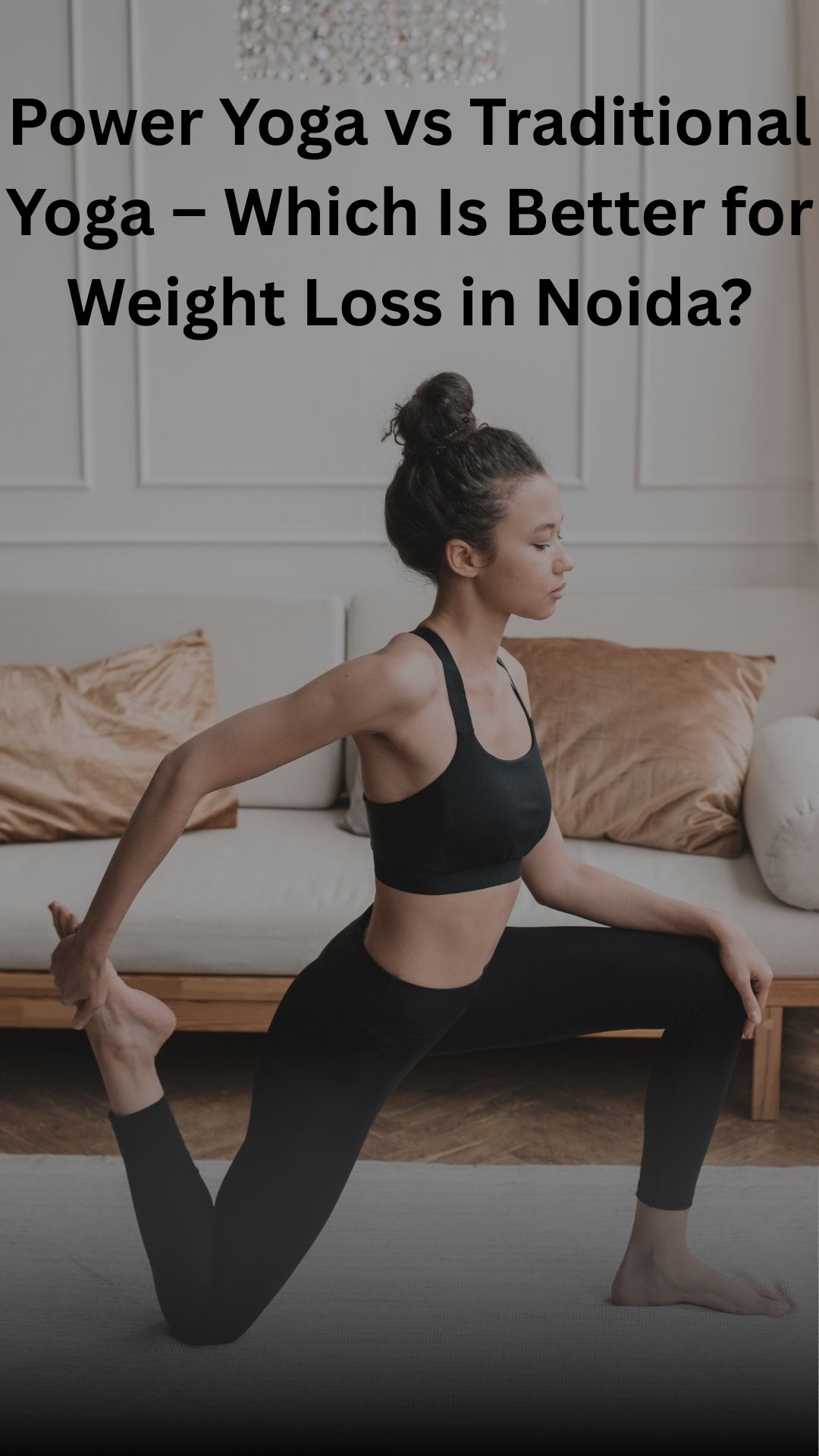If you’re searching for power yoga vs traditional yoga Noida, you’re likely trying to pick the fastest, safest path to real weight loss. The truth: both styles can help you slim down—but they do it differently. Power Yoga delivers a higher-intensity burn and visible toning; Traditional Yoga builds consistency, mobility, and stress control so your results actually stick. In a busy city like Noida, the winning formula is often a smart blend of the two.
At local studios in Sector 77 and Sector 117, you’ll typically find morning batches (6:00–7:00 AM, 7:00–8:00 AM, 8:00–9:00 AM) and an evening batch (6:30–7:30 PM) on most weekdays and Saturdays, with working hours around 6:00 AM–8:00 PM. That range makes it realistic to stay consistent—the most important factor in weight loss.
What Exactly Is Power Yoga?
Power Yoga is a vigorous, fitness-forward interpretation of traditional practices. Expect steady flows, faster transitions, repeated Sun Salutations, and strength-focused holds such as planks, lunges, chair pose, and balance work.
Why it helps with fat loss
- Higher session intensity: Continuous movement raises heart rate for a stronger calorie burn.
- Lean muscle stimulus: Strength holds help you look tighter and support metabolism.
- Time-efficient: Great for 45–60 minute evening slots after work.
Best for: People who enjoy a sweatier class, want visible toning, and like the “flow” feeling.
What Counts as Traditional Yoga?
“Traditional” covers Hatha, Iyengar, and classical Ashtanga basics. These formats emphasize alignment, breath, props (blocks/straps), and joint safety. The pace is steadier, but the benefits are enormous for mobility, posture, recovery, and stress reduction—all crucial for sustainable fat loss.
Why it helps with fat loss
- Lower stress, better sleep: Calmer nerves = fewer cravings and better food decisions.
- Mobility & alignment: Move better, hurt less, stick to your routine longer.
- Habit building: You can show up more often because recovery is built in.
Best for: Beginners, returners after a break, and anyone managing knee/back/shoulder niggles.
Table: Power Yoga vs Traditional Yoga for Weight Loss
| Aspect | Power Yoga | Traditional Yoga |
|---|---|---|
| Session pace | Fast, athletic, flow-heavy | Steady, alignment-led |
| Immediate calorie burn | Generally higher | Moderate, depends on style |
| Strength & toning | Strong emphasis (arms, core, legs) | Gradual, via controlled holds |
| Stress relief | Good through breath + effort | Excellent—deep relaxation & recovery |
| Injury risk | Higher if you rush form | Lower; form and props help |
| Beginner-friendliness | Moderate (with scaling) | Very high (progressions, props) |
| Best role in fat loss | Quick burn + lean mass | Consistency + recovery + mobility |
Bottom line: For most people, a hybrid week—2–3 Power Yoga sessions for intensity plus 1–2 Traditional sessions for mobility and recovery—delivers the steadiest, safest weight loss.
How Yoga (Any Style) Drives Weight Loss
- Energy expenditure: Flows and holds raise heart rate and burn calories.
- Muscle maintenance: Time under tension preserves or builds lean mass.
- Hormonal balance: Breath-led practice tempers stress, improving appetite control.
- Adherence: Enjoyable, convenient classes make you show up—consistency compounds.
A Noida-Friendly Plan (Real Life Considered)
Traffic, heat, and office hours are real. That’s why the 6–9 AM window and the 6:30–7:30 PM evening batch are golden. Choose the time you can hit most weeks, not just on “perfect” days. Working hours around 6:00 AM–8:00 PM also make it easier to slot in consults or recovery sessions.
Sample weekly template
- Mon: Power Yoga (full-body strength + flow)
- Tue: Traditional Hatha/Iyengar (mobility + breath)
- Wed: Power Yoga (core + balance)
- Thu: Restorative/Stretch (downshift stress)
- Fri: Power Yoga (strength emphasis; slow eccentrics)
- Sat: Traditional (alignment, props, technique)
- Sun: Optional easy walk, pranayama, or complete rest
Technique Tips That Multiply Results
- Own the basics: Quality planks, lunges, and hip hinges protect joints and boost results.
- Breathe like a metronome: Steady nasal breath; lengthen exhales to manage effort and stress.
- Progress gradually: Add seconds to holds, slow down the lowering phases, or use props to expand range safely.
- Recover hard: One restorative session per week improves sleep and reduces cravings.
- Be consistent, not perfect: Three to five sessions weekly beat any “all-or-nothing” sprint.
8-Week Hybrid Roadmap for Fat Loss
Weeks 1–2 — Foundation
- 2× Traditional (alignment, breath)
- 1× Power (light-moderate)
- 2× brisk walks (20–30 minutes)
Weeks 3–4 — Build
- 2× Power (one flowy, one strength-biased)
- 1–2× Traditional (hips/shoulders + restorative)
- Track daily steps (6–8k)
Weeks 5–6 — Intensify
- 3× Power (full-body, core/balance, strength)
- 1× Traditional (mobility reset)
- Gentle nutrition upgrades (protein, veggies, mindful sugar)
Weeks 7–8 — Consolidate
- 2× Power (quality over quantity)
- 2× Traditional (technique + recovery)
- Sleep target: 7–8 hours
Who Should Choose What?
- If you love a strong sweat: Start with Power Yoga twice weekly; add one Traditional class to stay supple.
- If you’re brand new or coming back: Begin with Traditional twice weekly; add one gentle Power class after two weeks.
- If you have aches or previous injuries: Prioritize Traditional; layer Power gradually with coach-approved modifications.
- If your schedule is chaotic: Lock a single batch time (e.g., 7–8 AM). Predictability beats intensity.
Common Misconceptions (Debunked)
- “Only fast classes burn fat.” Recovery and sleep quality drive fat loss too—Traditional Yoga helps you win those.
- “Traditional Yoga is too easy.” Slow does not mean simple; precision builds strength you’ll actually keep.
- “Power Yoga is risky.” It’s risky only when form is rushed. With scaling and coaching, it’s safe and effective.
The Verdict for Noida
If the question is power yoga vs traditional yoga Noida, the answer isn’t either/or. Use Power Yoga for a higher burn and visible toning; use Traditional Yoga for mobility, recovery, and stress control. Pair them to fit your real week, show up consistently, and watch the inches drop without burning out.
FAQs: Power Yoga vs Traditional Yoga Noida
Q1. Which is better for weight loss—Power Yoga or Traditional Yoga?
Power Yoga usually burns more calories per session. Traditional Yoga makes consistency and recovery easier. Most people do best with 2–3 Power + 1–2 Traditional sessions weekly.
Q2. I’m a beginner. Can I attend Power Yoga?
Yes, with proper scaling and coaching. Start conservatively, learn key shapes (plank, lunge, chair), and progress gradually.
Q3. What class timings work well for office-goers in Noida?
Early 6:00–9:00 AM batches or an evening 6:30–7:30 PM slot suit most routines. Pick the one you can hit regularly.
Q4. Can Traditional Yoga alone reduce weight?
Yes—especially when you pair it with daily steps, simple nutrition, and good sleep. Lower stress = fewer cravings and better choices.
Q5. How many sessions per week should I aim for?
Three to five total sessions (any mix) is a strong target. If time is tight, try two Power classes and one Traditional session.
Q6. I have knee or back pain. Which style is safer?
Start with Traditional to rebuild mobility and alignment. Add Power slowly, with modifications and clear form cues.
Q7. How soon will I see results?
Most people report lighter energy and better sleep within 2 weeks, visible toning by 4–6 weeks, and steady inch loss by 8 weeks—assuming consistent practice and reasonable nutrition.
Q8. Do I need props?
Blocks and straps help you access alignment without strain—especially in Traditional classes. They’re optional but highly useful.
Conclusion
Don’t frame it as a fight between styles. In Noida’s real-world schedules, your best weight-loss engine is a hybrid plan you can stick to: Power for intensity, Traditional for recovery. Choose a convenient morning or evening batch, commit for eight weeks, and let consistency do the heavy lifting—literally and figuratively.

